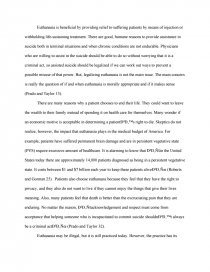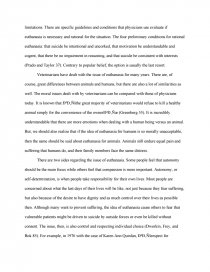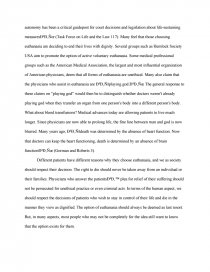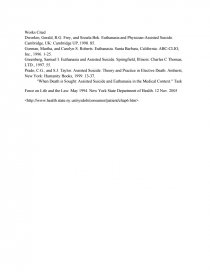Euthanasia
Essay by 24 • April 21, 2011 • 1,082 Words (5 Pages) • 944 Views
Euthanasia is beneficial by providing relief to suffering patients by means of injection or withholding life-sustaining treatment. There are good, humane reasons to provide assistance in suicide both in terminal situations and when chronic conditions are not endurable. Physicians who are willing to assist in the suicide should be able to do so without worrying that it is a criminal act, so assisted suicide should be legalized if we can work out ways to prevent a possible misuse of that power. But, legalizing euthanasia is not the main issue. The main concern is really the question of if and when euthanasia is morally appropriate and if it makes sense (Prado and Taylor 13).
There are many reasons why a patient chooses to end their life. They could want to leave the wealth to their family instead of spending it on health care for themselves. Many wonder if an economic motive is acceptable in determining a patient’s right to die. Skeptics do not realize, however, the impact that euthanasia plays in the medical budget of America. For example, patients have suffered permanent brain damage and are in persistent vegetative state (PVS) require excessive amount of healthcare. It is alarming to know that “in the United States today there are approximately 14,000 patients diagnosed as being in a persistent vegetative state. It costs between $1 and $7 billion each year to keep these patients alive” (Roberts and Gorman 25). Patients also choose euthanasia because they feel that they have the right to privacy, and they also do not want to live if they cannot enjoy the things that give their lives meaning. Also, many patients feel that death is better than the excruciating pain that they are enduring. No matter the reason, “acknowledgement and respect must come from acceptance that helping someone who is incapacitated to commit suicide shouldn’t always be a criminal act” (Prado and Taylor 32).
Euthanasia may be illegal, but it is still practiced today. However, the practice has its limitations. There are specific guidelines and conditions that physicians use evaluate if euthanasia is necessary and rational for the situation. The four preliminary conditions for rational euthanasia: that suicide be intentional and uncorked, that motivation be understandable and cogent, that there be no impairment in reasoning, and that suicide be consistent with interests (Prado and Taylor 37). Contrary to popular belief, the option is usually the last resort.
Veterinarians have dealt with the issue of euthanasia for many years. There are, of course, great differences between animals and humans, but there are also a lot of similarities as well. The moral issues dealt with by veterinarians can be compared with those of physicians today. It is known that “the great majority of veterinarians would refuse to kill a healthy animal simply for the convenience of the owner” (Greenberg 55). It is incredibly understandable that there are more emotions when dealing with a human being versus an animal. But, we should also realize that if the idea of euthanasia for humans is so morally unacceptable, then the same should be said about euthanasia for animals. Animals still endure equal pain and suffering that humans do, and their family members face the same distress.
There are two sides regarding the issue of euthanasia. Some people feel that autonomy should be the main focus while others feel that compassion is more important. Autonomy, or self-determination, is when people take responsibility for their own lives. Most people are concerned about what the last days of their lives will be like, not just because they fear suffering, but also because of the desire to have dignity and as much control over their lives as possible then. Although many want to prevent suffering, the idea of euthanasia cause others to fear that vulnerable patients might be driven to suicide by outside forces or even be killed without consent. The issue, then, is also control and respecting individual choice (Dworkin, Frey, and Bok 85). For example, in 1976 with the case of Karen Ann Quinlan, “respect for autonomy has been a critical guidepost for court decisions and legislation about life-sustaining measures” (Task Force
...
...



